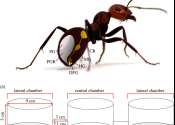World's chocolate supply threatened by devastating virus
A rapidly spreading virus threatens the health of the cacao tree and the dried seeds from which chocolate is made, jeopardizing the global supply of the world's most popular treat.

A rapidly spreading virus threatens the health of the cacao tree and the dried seeds from which chocolate is made, jeopardizing the global supply of the world's most popular treat.
Molecular & Computational biology
Apr 23, 2024
0
208

The Netherlands is losing plant species that rely on pollination by insects. Leiden environmental scientist Kaixuan Pan demonstrates this after analyzing 87 years of measurements from more than 365,000 plots. The news is ...
Plants & Animals
Apr 22, 2024
0
20

Have you ever wondered if there are more insects out at night than during the day?
Plants & Animals
Apr 19, 2024
0
3

Researchers led by a scientist at Keele University in Staffordshire have studied the previously unknown flight mechanisms of a common crop pest, to learn more about their movements in a bid to improve food security and prevent ...
Ecology
Apr 19, 2024
0
21

Many of us would love the superpower to fly, and for good reason: Flight offers a crucial evolutionary advantage. Flying enables an animal to travel large distances quickly, in search of food and new habitats, while expending ...
Plants & Animals
Apr 18, 2024
0
30

Using a pair of sensors made from carbon nanotubes, researchers from MIT and the Singapore-MIT Alliance for Research and Technology (SMART) have discovered signals that reveal when plans are experiencing stresses such as ...
Biotechnology
Apr 17, 2024
0
28

From microbes in the human gut to symbiotic algae in coral reefs, research in recent decades has increasingly revealed the pivotal roles that microorganisms (or microbial species) play in shaping the biology of host organisms ...
Evolution
Apr 17, 2024
0
4

Over the last few years, Professor Halil Ibrahimi from Kosovo and his team have described several new species of aquatic insects recognized as bioindicators of freshwater ecosystems. The work is published in the Biodiversity ...
Plants & Animals
Apr 15, 2024
0
16

If you're outside enjoying the spring sunshine, then chances are, ticks are too. However, new research from Simon Fraser University (SFU) suggests the use of ant pheromones as a topical repellent, or as an environmental barrier, ...
Ecology
Apr 11, 2024
0
86

Wasp scientists around the globe agree that media coverage of wasps skews negative and almost entirely overlooks their beneficial attributes, reports a team led by UCL researchers.
Plants & Animals
Apr 8, 2024
0
1
Insects (Class Insecta) are arthropods, having a hard exoskeleton, a three-part body (head, thorax, and abdomen), three pairs of jointed legs, compound eyes, and two antennae. They are the most diverse group of animals on the planet and include approximately 30 gladiator and icebug, 35 Zoraptera, 150 snakefly, 200 silverfish, 300 alderfly, 300 webspinner, 350 jumping bristletail, 550 scorpionfly, 600 Strepsiptera, 1,200 caddisfly, 1,700 stonefly, 1,800 earwig, 2,000 flea, 2,200 mantis, 2,500 mayfly, 3,000 louse, 3,000 walking stick, 4,000 cockroach, 4,000 lacewing, 4,000 termite, 5,000 dragonfly, 5,000 thrips, 5,500 booklouse, 20,000 cricket, grasshopper, and locust, 82,000 true bug, 110,000 ant, bee, sawfly, and wasp, 120,000 true fly, 170,000 butterfly and moth, and 360,000 beetle species described to date. The number of extant species is estimated at between six and ten million, with over a million species already described. Insects represent more than half of all known living organisms and potentially represent over 90% of the differing life forms on Earth. Insects may be found in nearly all environments, although only a small number of species occur in the oceans, a habitat dominated by another arthropod group, the crustaceans.
Adult modern insects range in size from a 0.139 mm (0.00547 in) fairyfly (Dicopomorpha echmepterygis) to a 56.7-centimetre (22.3 in) long stick insect (Phobaeticus chani). The heaviest documented present-day insect was 70 g (2½ oz) Giant Weta, though the Goliath beetles Goliathus goliatus, Goliathus regius and Cerambycid beetles such as Titanus giganteus hold the title for some of the largest species in general.
The largest known extinct insect is a kind of dragonfly, Meganeura.
This text uses material from Wikipedia, licensed under CC BY-SA